HISTORY 135F
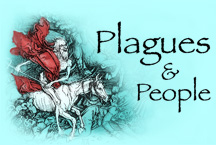
Infectious and
Epidemic Disease in History
Department of History
University of California, Irvine
Instructor: Dr. Barbara J. Becker
HISTORY 135F

Infectious and
Epidemic Disease in History
Department of History
University of California, Irvine
Instructor: Dr. Barbara J. Becker
| An Account, or History, of the Procuring the SMALL POX by Incision, or Inoculation; as it has for some time been practised at Constantinople. Being the Extract of a Letter from Emanuel Timonius, Oxon. & Patav. M.D. S. R. S. dated at Constantinople, December, 1713. Communicated to the Royal Society by John Woodward, M. D. Profes. Med. Gresh. and S. R. S. Philosophical Transactions of the Royal Society, Volume 29, Number 339 (1714), pp. 72-92. | |
Lady Wortley Montagu (1689-1762) |
|
| Dec 1715 |
|
| Apr 1717 |
|
| Mar 1718 |
|
| Spring 1721 |
|
| Spring 1722 |
|
| Summer 1722 |
|
Edward Jenner (1749-1843) |
After a lengthy series of experiments, Jenner published his results in An Inquiry into the Causes and Effects of the Variolae Vaccinae.... (1798). The public responded with a mixture of enthusiasm and fear! |
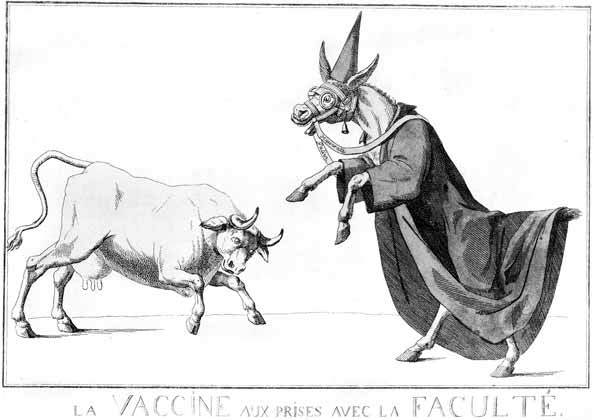
An assertive cow charges threateningly at the wary medical establishment depicted by an ass with reins belonging to Galen and Hippocrates. |
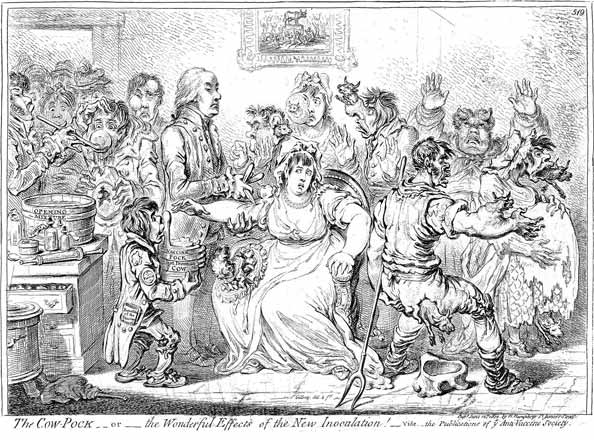
"Cow Pock ... or ... the Wonderful Effects of the New Inoculation!" (1802) by James Gillray
|
Vaccination in the US: The North Carolina Accident |
|
1801 Nov 5 |
Thomas Jefferson describes his own successful program of vaccination conducted at Monticello |
1812 Mar 23 |
Dr. James Smith of Baltimore writes to US Congress; introduces plan to safely inoculate people against smallpox using Jenner's method of vaccination |
1813 Feb 27 |
US Congress passes "An Act to Encourage Vaccination" |
1821 Nov 1 |
Smith, now "Agent of Vaccination" of the National Vaccine Institution, sends out samples of "kine pox scabs" to Drs. John Ward and Benjamin Hunter in North Carolina urging them to use it to vaccinate their patients |
Dec 29 |
Ward writes to Smith; reports 12 out of 15 vaccinated have become ill with what seems like smallpox |
1822 Jan 10 |
Smith replies to Ward; requests detailed information on situation |
Jan 14 |
Smith writes to Hunter; inquires about status of his vaccination program |
Jan 16 |
Hunter confirms smallpox outbreak among Ward's patients; reports that it has spread by contact to others; two fatalities |
Jan 19 |
Hunter adds that scabs he was sent seem to have had no effect on his patients |
Jan 28 |
Ward writes to Smith; reports 5 fatalities; 40-50 victims ill |
Mar 20 |
Smith expresses concern that Congress may repeal the Vaccination Act, thus ending US vaccination program |
Apr 10 |
John Quincy Adams (Secretary of State) writes to Smith revoking his commission |
Apr 13 |
House of Representatives discusses repealing the vaccination law |
Apr 29 |
HR votes to repeal law (102-57) |
May 1 |
Senate votes to repeal law (29-6) |
Medical practitioners' opinions regarding the best way to prevent the transmission of infectious disease depended on the theory of disease to which they subscribed:
Incidents like the unfortunate "accident" in North Carolina raised many questions and concerns over the safety and value of vaccination. |
||||||||||
|
Doctor.--Bring your babe now for vaccination!
Nine days after this conversation and following vaccination, Tom was a corpse, with two vaccine-blisters on each arm. |
||||||||||
|
A mighty and horrible monster, with the horns of a bull, the hind hoofs of a horse, the jaws of a krakin, the teeth and claws of a tyger, the tail of a cow, all the evils of Pandora's box in his belly, plague, pestilence, leprosy, purple blotches, foetid ulcers, and filthy running sores covering his body, and an atmosphere of accumulated disease, pain and death around him, has made his appearance in the world, and devours mankind,--especially poor helpless infants,--not by scores only, or hundreds, or thousands, but by hundreds of thousands of thousands. This monster has been named vaccination; and his progressive havoc among the human race, has been dreadful and most alarming. Yet, strange to tell, this monster has found not only a multitude of friends but worshipers, who prostrate themselves before him, and encourage his voracious appetite. Do not the men, the heroes--who first dared to stand forth to arrest the progress, and stop the fatal havoc of this most dreadful and destructive monster, and at length have bravely subdued and put him to flight with all his mighty host, merit an obelisk erected to their fame, with their names inscribed upon it, in indelible characters, to be held in grateful rememberence through all future generations? And are not these names [Dr. Benjamin] MOSELEY, [Dr. William] ROWLEY, [Dr. John] BIRCH, SQUIRRELL, LIPSCOMB? |
Testimonies of Medical Authorities on Vaccination
|
DR. SQUIRRELL, of the London Small-Pox Hospital, a Contemporary of JENNER,
JOHN BIRCH, Surgeon Extraordinary to the Prince of Wales, and Surgeon to St. Thomas's Hospital, 1804-7[:]
MR. BIRCH concludes as the result of observation and experience:
EXTRACT FROM THE REPORT OF THE FIRST VACCINE INSTITUTION:.... WILLIAM ROWLEY, a Member of the University of Oxford, and of the Royal College of Physicians in London; Physician Extraordinary to Her Majesty's Lying-in-Hospital, 1805; Public Lecturer on the Theory and Practice of Medicine, &c.
|
Nevertheless, by the end of the nineteenth century--a century after Jenner published his report on vaccination, some were willing to accept vaccination as a major medical achievement. |
The International Cyclopaedia: A Compendium of Human Knowledge (1898)
|
|
SMALL-POX, or VARIOLA ...The cause of small-pox is universally allowed to be a specific contagion, of whose nature we are in the most profound ignorance. There is probably no disease so contagious as this.... The contagion acts either through the air, or by contact with the skin, or by inoculation; and the disease may be caused by the dead body, even when it has not been touched. What products of the diseased body are contagious is not exactly known, but the contents of the pustules and the dried scabs certainly are so. Opinions are divided as to the period at which the disease begins and ceases to be contagious.... [T]he stability of the contagious principle may be inferred from the fact, that clothing will retain it for months, and it is said for years, when confined.... It is universally admitted that the discovery of vaccination, by which small-pox is deprived of its danger, is the greatest triumph of modern medicine.... |
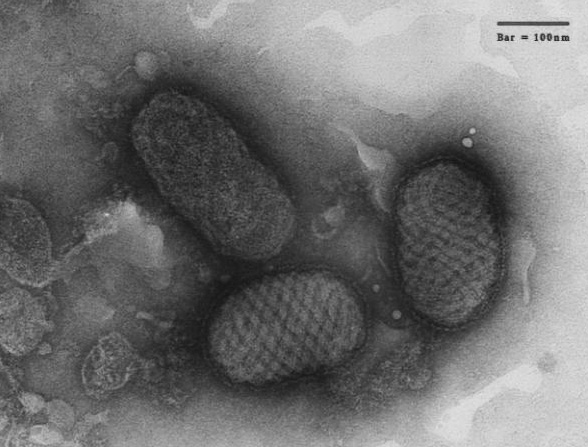
The smallpox virus. |
| Ordinary smallpox | ~20-30% fatal |
|
10-14 days |
|
sudden onset of symptoms marks end of incubation period |
|
2-3 days after first symptoms appear
|
| Extreme smallpox (black pox) | ~ 100% fatal |
| 1950s |
|
| 1958 |
|
| 1965 |
|
| 1967 |
|
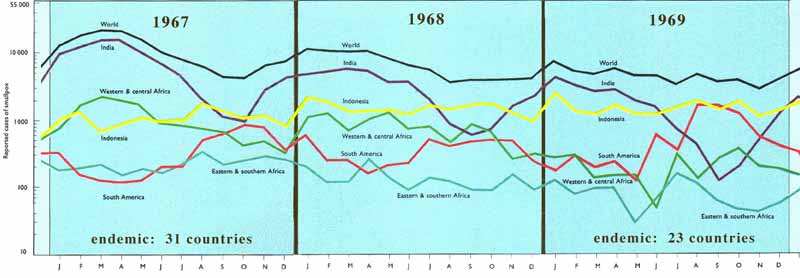
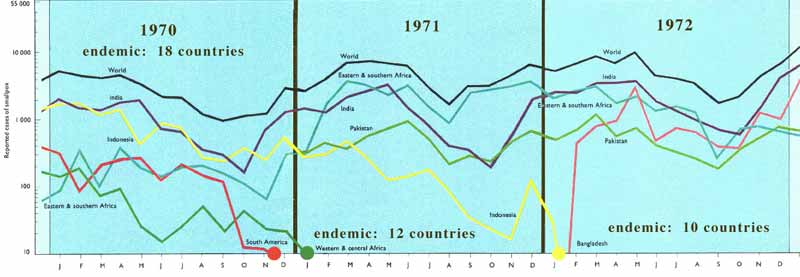
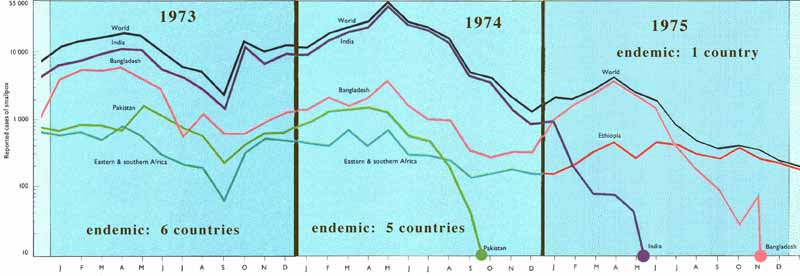
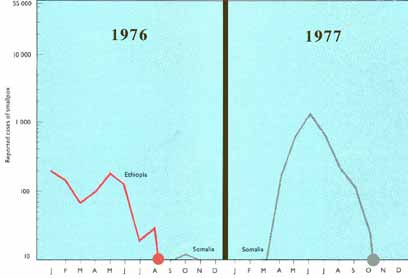 |
· South America (1970)
· Western and central Africa (1971) · Indonesia (Jan 1972) · Pakistan (Oct 1974) · India (May 1975) · Bangladesh (Nov 1975) · Eastern and southern Africa (1977) · Ethiopia (Aug 1976) · Somalia (Oct 1977) · World (May 1980) |
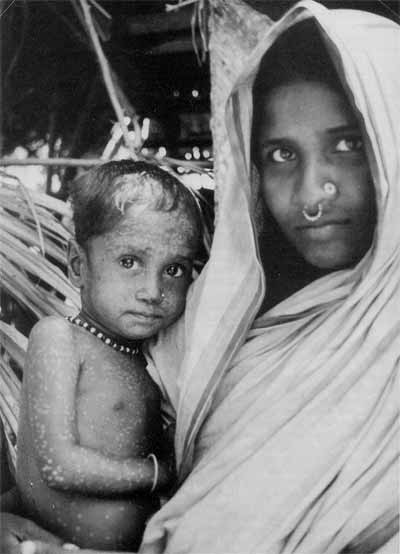
In November 1975, 3-year-old Rahima Banu of Bangladesh became the world's last case of naturally transmitted variola major. _____________ 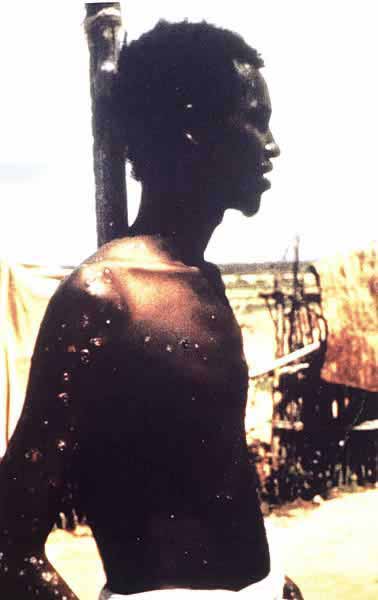
In October 1977, 23-year-old Ali Maow Maalin of Somalia became the world's last case of naturally transmitted variola minor. ____________________ |
On May 8, 1980 the World Health Assembly formally declared:
[T]the World and all its peoples have won freedom from smallpox, which was a devastating disease sweeping in epidemic form through many countries since earliest times, leaving death, blindness, and disfigurement in its wake and which only a decade ago was rampant in Africa, Asia, and South America. |
Now what?? The U.S. Centers for Disease Control in Atlanta and Russia's Research Institute for Viral Preparations in Moscow contain the only known specimens of smallpox virus.
|
 |
| Go to: |
|
|